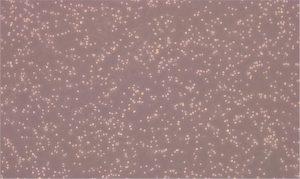HLA Typed Cells
The major histocompatibility complex (MHC) is a set of genes that code for cell surface proteins. These proteins are essential for the immune system to recognize foreign molecules. In humans, the MHC complex is called Human Leukocyte Antigen (HLA). HLA information has been and still is a critical factor for donor/recipient matching for organ and bone marrow transplants (1). Currently the need for HLA typed cells is driven by personalized cell therapies, cancer vaccine development and patient stratification for immune-oncology drug discovery (2).
HLA typing is used to genotype individuals at these loci. Historically this information was gathered serologically but with the advent of molecular technologies, more precise sequence information can be obtained with the use of next generation sequencing. HLA typed cells are critical in designing in vitro assays to identify on-and off-target cross -reactivities with proteins expressed on different tissues. Thus knowing the HLA genotype has become critical information for preclinical cell therapy and drug safety assessment studies (2).
- HLA characterization from 50 different primary cell types from different tissues enables broad screening for cross reactivity testing
- HLA Class I -A, B, C and Class II HLA-DPA1, -DPB1, -DQA1, DQB1, DRB1, available for cells obtained from major tissue types such as whole blood, leukopak, mobilized leukopak , bone marrow, lung, liver, skin, kidney, intestine, muscle, heart, cartilage, breast, brain, bone, eye.
- High resolution HLA in for greater than 100 lots obtained by gold standard next generation sequencing methodologies (NGS) for class I and class II alleles
- Detailed 2 field (6 digit) high resolution HLA data , (i.e the HLA prefix followed by gene name and 2 fields of the allele eg. HLA-A *02:01) for select lots and continuously expanding
- Select the HLA type of your choice from multiple donors representing different genders and ethnicities across the population.
- Multiple cell types from single donor tissue enables matched donor experiments Cord blood CD34+ cells can be HLA typed as a service through Cell Bio Services
- Data will be included on the CoA.
Application for Use of HLA Typed cells
In the development of cancer immunotherapies, it is frequently critical to have primary cells from various tissues with a specific HLA genotype. The main areas for application of HLA typed primary cells are
- For development of engineered TCRs to optimally select for HLA-TCR- peptide complex with the highest immunogenicity (3)
- For development of therapeutic antibodies known as TCR like antibodies targeting the peptide MHC (pMHC antibodies) (4,5,6,7)
- Cross reactivity testing across multiple tissue types for assessment of risk of development of cytokine storm or direct cytotoxicity(8,9,10)
- For studying the development of anti-drug antibodies (ADAs)(11)
- For development of neo-antigen peptide vaccines in cancer therapeutics (12,13,14)
Thus, HLA information is a critical piece of information needed in the development of preclinical invitro assays in the immune oncology drug discovery field.
Cell Types for HLA Typing
Basics of HLA
MHC proteins supports self (our normal cells and tissues) vs non self-recognition (pathogens or modified self/cancer), in coordination with T Cell Receptor proteins(TCR) . T cells recognize foreign antigen/non- self peptide as a complex with MHC. Three classes of HLA exists in humans. MHC Class I is found on all nucleated cells in the body. 3 major genes (A, B, C) comprise the Class I locus. MHC class I proteins displays peptides from within cells to T cells. Class II is found in addition to class I on antigen-presenting immune cells such as dendritic cells, B-cells, monocytes, macrophages. There are 6 main class II genes (DPA1, DPB1, DQA1, DQB1, DRA, DRB1). MHC class II displays peptides derived from exogenous antigens such as bacteria or viruses.. HLA-I molecules are both polygenic—being encoded by three genes (HLA-A, HLA-B, and HLA-C)—and highly polymorphic, with over 10,000 distinct alleles described thus far [1]. The combination of multiple genes and alleles ensures enough diversification of HLA molecules to bind and present a wide range of peptides for T cell recognition and activation
References
- Int. J. Immunogenet. 2019 Oct;46(5):307-320.Carey BS, Poulton KV, Poles A. Factors affecting HLA expression: A review.
- Cancer Control 2015 Jan;22(1):79-86. Using HLA typing to support patients with cancer. https://journals.sagepub.com/doi/pdf/10.1177/107327481502200110
- Cancer Immunol Immunother. 2019 Nov;68(11):1881-1889. Understanding TCR affinity, antigen specificity, and cross-reactivity to improve TCR gene-modified T cells for cancer immunotherapy. https://pubmed.ncbi.nlm.nih.gov/31595324/
- Antibodies 2019 May 9;8(2):32. Targeting the MHC Ligandome by Use of TCR-Like Antibodies. https://www.ncbi.nlm.nih.gov/pmc/articles/PMC6640717/
- Methods Mol Biol.2019;1904:253-291. Antigen-Specific Human Monoclonal Antibodies from Transgenic Mice. https://pubmed.ncbi.nlm.nih.gov/30539474/
- FASEB J . 2018 Mar;32(3):1537-1549. Humanized mice in studying efficacy and mechanisms of PD-1-targeted cancer immunotherapy. https://pubmed.ncbi.nlm.nih.gov/29146734/
- PLoS One 2017 May 31;12(5): Quantitative analysis of the CD4+ T cell response to therapeutic antibodies in healthy donors using a novel T cell: PBMC assay. https://pubmed.ncbi.nlm.nih.gov/28562666/
- J Immunother. 2013 Feb; 36(2): 133–151. Cancer regression and neurologic toxicity following anti-MAGE-A3 TCR gene therapy. https://pubmed.ncbi.nlm.nih.gov/23377668/
- Blood. 2013 Aug 8; 122(6): 863–871. Cardiovascular toxicity and titin cross-reactivity of affinity-enhanced T cells in myeloma and melanoma. https://pubmed.ncbi.nlm.nih.gov/23770775/
- Mol Ther. 2010 Apr; 18(4): 843–851. Case Report of a Serious Adverse Event Following the Administration of T Cells Transduced With a Chimeric Antigen Receptor Recognizing ERBB2. https://pubmed.ncbi.nlm.nih.gov/20179677/
- Expert Opin Drug Metab Toxicol 2018 Mar;14(3):261-274. Implications of HLA-allele associations for the study of type IV drug hypersensitivity reactions. https://pubmed.ncbi.nlm.nih.gov/29460640/
- Science 2015 Apr 3;348(6230):69-74. Neoantigens in cancer immunotherapy. https://pubmed.ncbi.nlm.nih.gov/25838375/
- International Immunology, Volume 28, Issue 7, July 2016, Pages 319–328. The present status and future prospects of peptide-based cancer vaccines. https://academic.oup.com/intimm/article/28/7/319/1750235
- Clinical Trial:Nature2017 Jul 13;547(7662):217-221. An immunogenic personal neoantigen vaccine for patients with melanoma. https://pubmed.ncbi.nlm.nih.gov/28678778/





